Can Zheng
Multimodal Radio and Vision Fusion for Robust Localization in Urban V2I Communications
Aug 25, 2025Abstract:Accurate localization is critical for vehicle-to-infrastructure (V2I) communication systems, especially in urban areas where GPS signals are often obstructed by tall buildings, leading to significant positioning errors, necessitating alternative or complementary techniques for reliable and precise positioning in applications like autonomous driving and smart city infrastructure. This paper proposes a multimodal contrastive learning regression based localization framework for V2I scenarios that combines channel state information (CSI) with visual information to achieve improved accuracy and reliability. The approach leverages the complementary strengths of wireless and visual data to overcome the limitations of traditional localization methods, offering a robust solution for V2I applications. Simulation results demonstrate that the proposed CSI and vision fusion model significantly outperforms traditional methods and single modal models, achieving superior localization accuracy and precision in complex urban environments.
M2BeamLLM: Multimodal Sensing-empowered mmWave Beam Prediction with Large Language Models
Jun 17, 2025Abstract:This paper introduces a novel neural network framework called M2BeamLLM for beam prediction in millimeter-wave (mmWave) massive multi-input multi-output (mMIMO) communication systems. M2BeamLLM integrates multi-modal sensor data, including images, radar, LiDAR, and GPS, leveraging the powerful reasoning capabilities of large language models (LLMs) such as GPT-2 for beam prediction. By combining sensing data encoding, multimodal alignment and fusion, and supervised fine-tuning (SFT), M2BeamLLM achieves significantly higher beam prediction accuracy and robustness, demonstrably outperforming traditional deep learning (DL) models in both standard and few-shot scenarios. Furthermore, its prediction performance consistently improves with increased diversity in sensing modalities. Our study provides an efficient and intelligent beam prediction solution for vehicle-to-infrastructure (V2I) mmWave communication systems.
Can LLMs Generate Reliable Test Case Generators? A Study on Competition-Level Programming Problems
Jun 07, 2025Abstract:Large Language Models (LLMs) have demonstrated remarkable capabilities in code generation, capable of tackling complex tasks during inference. However, the extent to which LLMs can be utilized for code checking or debugging through test case generation remains largely unexplored. We investigate this problem from the perspective of competition-level programming (CP) programs and propose TCGBench, a Benchmark for (LLM generation of) Test Case Generators. This benchmark comprises two tasks, aimed at studying the capabilities of LLMs in (1) generating valid test case generators for a given CP problem, and further (2) generating targeted test case generators that expose bugs in human-written code. Experimental results indicate that while state-of-the-art LLMs can generate valid test case generators in most cases, most LLMs struggle to generate targeted test cases that reveal flaws in human code effectively. Especially, even advanced reasoning models (e.g., o3-mini) fall significantly short of human performance in the task of generating targeted generators. Furthermore, we construct a high-quality, manually curated dataset of instructions for generating targeted generators. Analysis demonstrates that the performance of LLMs can be enhanced with the aid of this dataset, by both prompting and fine-tuning.
Demonstrations of Integrity Attacks in Multi-Agent Systems
Jun 05, 2025Abstract:Large Language Models (LLMs) have demonstrated remarkable capabilities in natural language understanding, code generation, and complex planning. Simultaneously, Multi-Agent Systems (MAS) have garnered attention for their potential to enable cooperation among distributed agents. However, from a multi-party perspective, MAS could be vulnerable to malicious agents that exploit the system to serve self-interests without disrupting its core functionality. This work explores integrity attacks where malicious agents employ subtle prompt manipulation to bias MAS operations and gain various benefits. Four types of attacks are examined: \textit{Scapegoater}, who misleads the system monitor to underestimate other agents' contributions; \textit{Boaster}, who misleads the system monitor to overestimate their own performance; \textit{Self-Dealer}, who manipulates other agents to adopt certain tools; and \textit{Free-Rider}, who hands off its own task to others. We demonstrate that strategically crafted prompts can introduce systematic biases in MAS behavior and executable instructions, enabling malicious agents to effectively mislead evaluation systems and manipulate collaborative agents. Furthermore, our attacks can bypass advanced LLM-based monitors, such as GPT-4o-mini and o3-mini, highlighting the limitations of current detection mechanisms. Our findings underscore the critical need for MAS architectures with robust security protocols and content validation mechanisms, alongside monitoring systems capable of comprehensive risk scenario assessment.
BeamLLM: Vision-Empowered mmWave Beam Prediction with Large Language Models
Mar 13, 2025Abstract:In this paper, we propose BeamLLM, a vision-aided millimeter-wave (mmWave) beam prediction framework leveraging large language models (LLMs) to address the challenges of high training overhead and latency in mmWave communication systems. By combining computer vision (CV) with LLMs' cross-modal reasoning capabilities, the framework extracts user equipment (UE) positional features from RGB images and aligns visual-temporal features with LLMs' semantic space through reprogramming techniques. Evaluated on a realistic vehicle-to-infrastructure (V2I) scenario, the proposed method achieves 61.01% top-1 accuracy and 97.39% top-3 accuracy in standard prediction tasks, significantly outperforming traditional deep learning models. In few-shot prediction scenarios, the performance degradation is limited to 12.56% (top-1) and 5.55% (top-3) from time sample 1 to 10, demonstrating superior prediction capability.
Modeling Continuous Spatial-temporal Dynamics of Turbulent Flow with Test-time Refinement
Dec 27, 2024



Abstract:The precise simulation of turbulent flows holds immense significance across various scientific and engineering domains, including climate science, freshwater science, and energy-efficient manufacturing. Within the realm of simulating turbulent flows, large eddy simulation (LES) has emerged as a prevalent alternative to direct numerical simulation (DNS), offering computational efficiency. However, LES cannot accurately capture the full spectrum of turbulent transport scales and is present only at a lower spatial resolution. Reconstructing high-fidelity DNS data from the lower-resolution LES data is essential for numerous applications, but it poses significant challenges to existing super-resolution techniques, primarily due to the complex spatio-temporal nature of turbulent flows. This paper proposes a novel flow reconstruction approach that leverages physical knowledge to model flow dynamics. Different from traditional super-resolution techniques, the proposed approach uses LES data only in the testing phase through a degradation-based refinement approach to enforce physical constraints and mitigate cumulative reconstruction errors over time. Furthermore, a feature sampling strategy is developed to enable flow data reconstruction across different resolutions. The results on two distinct sets of turbulent flow data indicate the effectiveness of the proposed method in reconstructing high-resolution DNS data, preserving the inherent physical attributes of flow transport, and achieving DNS reconstruction at different resolutions.
Physics-enhanced Neural Operator for Simulating Turbulent Transport
May 31, 2024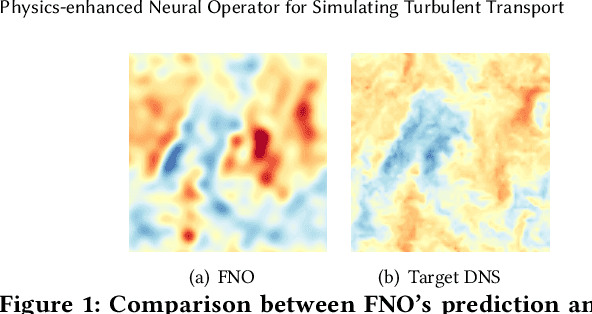
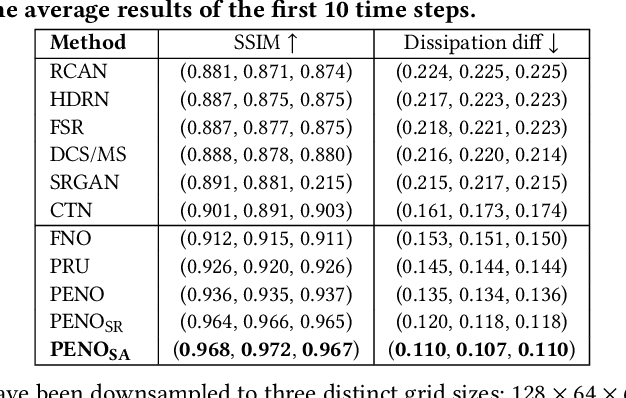
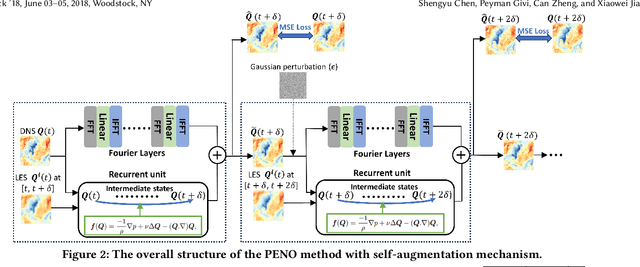
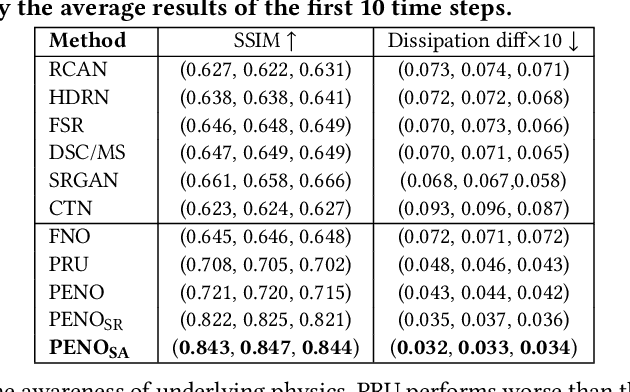
Abstract:The precise simulation of turbulent flows is of immense importance in a variety of scientific and engineering fields, including climate science, freshwater science, and the development of energy-efficient manufacturing processes. Within the realm of turbulent flow simulation, direct numerical simulation (DNS) is widely considered to be the most reliable approach, but it is prohibitively expensive for long-term simulation at fine spatial scales. Given the pressing need for efficient simulation, there is an increasing interest in building machine learning models for turbulence, either by reconstructing DNS from alternative low-fidelity simulations or by predicting DNS based on the patterns learned from historical data. However, standard machine learning techniques remain limited in capturing complex spatio-temporal characteristics of turbulent flows, resulting in limited performance and generalizability. This paper presents a novel physics-enhanced neural operator (PENO) that incorporates physical knowledge of partial differential equations (PDEs) to accurately model flow dynamics. The model is further refined by a self-augmentation mechanism to reduce the accumulated error in long-term simulations. The proposed method is evaluated through its performance on two distinct sets of 3D turbulent flow data, showcasing the model's capability to reconstruct high-resolution DNS data, maintain the inherent physical properties of flow transport, and generate flow simulations across various resolutions. Additionally, experimental results on multiple 2D vorticity flow series, generated by different PDEs, highlight the transferability and generalizability of the proposed method. This confirms its applicability to a wide range of real-world scenarios in which extensive simulations are needed under diverse settings.
Beyond One-Model-Fits-All: A Survey of Domain Specialization for Large Language Models
May 31, 2023



Abstract:Large language models (LLMs) have significantly advanced the field of natural language processing (NLP), providing a highly useful, task-agnostic foundation for a wide range of applications. The great promise of LLMs as general task solvers motivated people to extend their functionality largely beyond just a ``chatbot'', and use it as an assistant or even replacement for domain experts and tools in specific domains such as healthcare, finance, and education. However, directly applying LLMs to solve sophisticated problems in specific domains meets many hurdles, caused by the heterogeneity of domain data, the sophistication of domain knowledge, the uniqueness of domain objectives, and the diversity of the constraints (e.g., various social norms, cultural conformity, religious beliefs, and ethical standards in the domain applications). To fill such a gap, explosively-increase research, and practices have been conducted in very recent years on the domain specialization of LLMs, which, however, calls for a comprehensive and systematic review to better summarizes and guide this promising domain. In this survey paper, first, we propose a systematic taxonomy that categorizes the LLM domain-specialization techniques based on the accessibility to LLMs and summarizes the framework for all the subcategories as well as their relations and differences to each other. We also present a comprehensive taxonomy of critical application domains that can benefit from specialized LLMs, discussing their practical significance and open challenges. Furthermore, we offer insights into the current research status and future trends in this area.
Reconstructing Turbulent Flows Using Physics-Aware Spatio-Temporal Dynamics and Test-Time Refinement
Apr 24, 2023Abstract:Simulating turbulence is critical for many societally important applications in aerospace engineering, environmental science, the energy industry, and biomedicine. Large eddy simulation (LES) has been widely used as an alternative to direct numerical simulation (DNS) for simulating turbulent flows due to its reduced computational cost. However, LES is unable to capture all of the scales of turbulent transport accurately. Reconstructing DNS from low-resolution LES is critical for many scientific and engineering disciplines, but it poses many challenges to existing super-resolution methods due to the spatio-temporal complexity of turbulent flows. In this work, we propose a new physics-guided neural network for reconstructing the sequential DNS from low-resolution LES data. The proposed method leverages the partial differential equation that underlies the flow dynamics in the design of spatio-temporal model architecture. A degradation-based refinement method is also developed to enforce physical constraints and further reduce the accumulated reconstruction errors over long periods. The results on two different types of turbulent flow data confirm the superiority of the proposed method in reconstructing the high-resolution DNS data and preserving the physical characteristics of flow transport.
Graph-Augmented Cyclic Learning Framework for Similarity Estimation of Medical Clinical Notes
Aug 19, 2022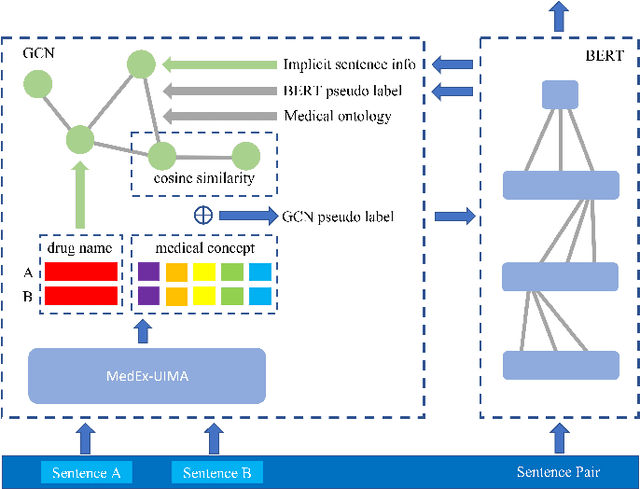


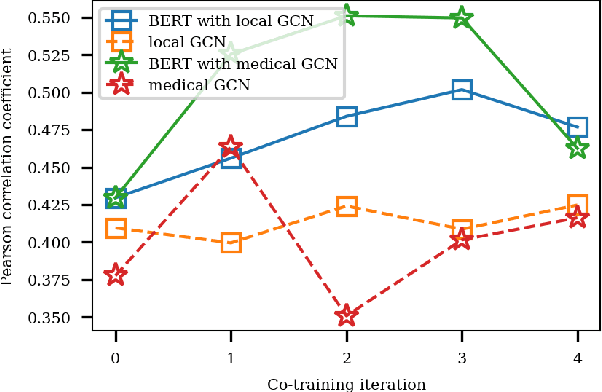
Abstract:Semantic textual similarity (STS) in the clinical domain helps improve diagnostic efficiency and produce concise texts for downstream data mining tasks. However, given the high degree of domain knowledge involved in clinic text, it remains challenging for general language models to infer implicit medical relationships behind clinical sentences and output similarities correctly. In this paper, we present a graph-augmented cyclic learning framework for similarity estimation in the clinical domain. The framework can be conveniently implemented on a state-of-art backbone language model, and improve its performance by leveraging domain knowledge through co-training with an auxiliary graph convolution network (GCN) based network. We report the success of introducing domain knowledge in GCN and the co-training framework by improving the Bio-clinical BERT baseline by 16.3% and 27.9%, respectively.
 Add to Chrome
Add to Chrome Add to Firefox
Add to Firefox Add to Edge
Add to Edge